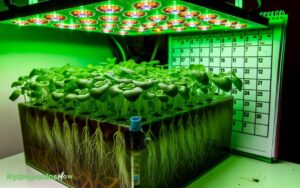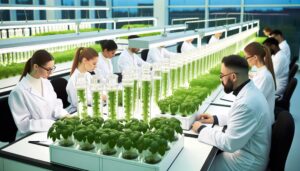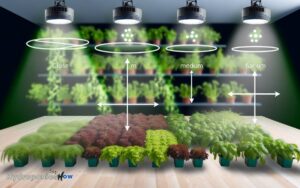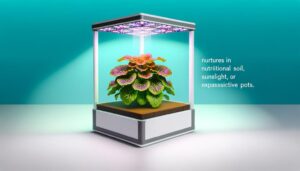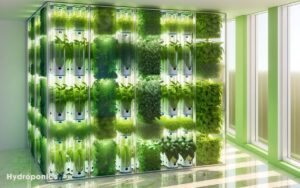Does Temperature Affect Plant Growth in Hydroponics?
In hydroponics, temperature has a substantial impact on plant growth. You should maintain air temperatures between 68°F and 75°F (20°C – 24°C) for ideal growth and root zone temperatures between 68°F and 77°F (20°C – 25°C).
Temperatures above 82°F (28°C) stress plants, reduce growth rates, and hinder nutrient uptake. Below 60°F (15°C), metabolic processes and root function slow down.
Water temperatures between 65°F and 75°F enhance nutrient absorption and prevent hypoxia. Use climate control systems and reliable sensors to monitor and stabilize temperatures.
To truly optimize your hydroponic setup, understanding these temperature effects in depth is essential.
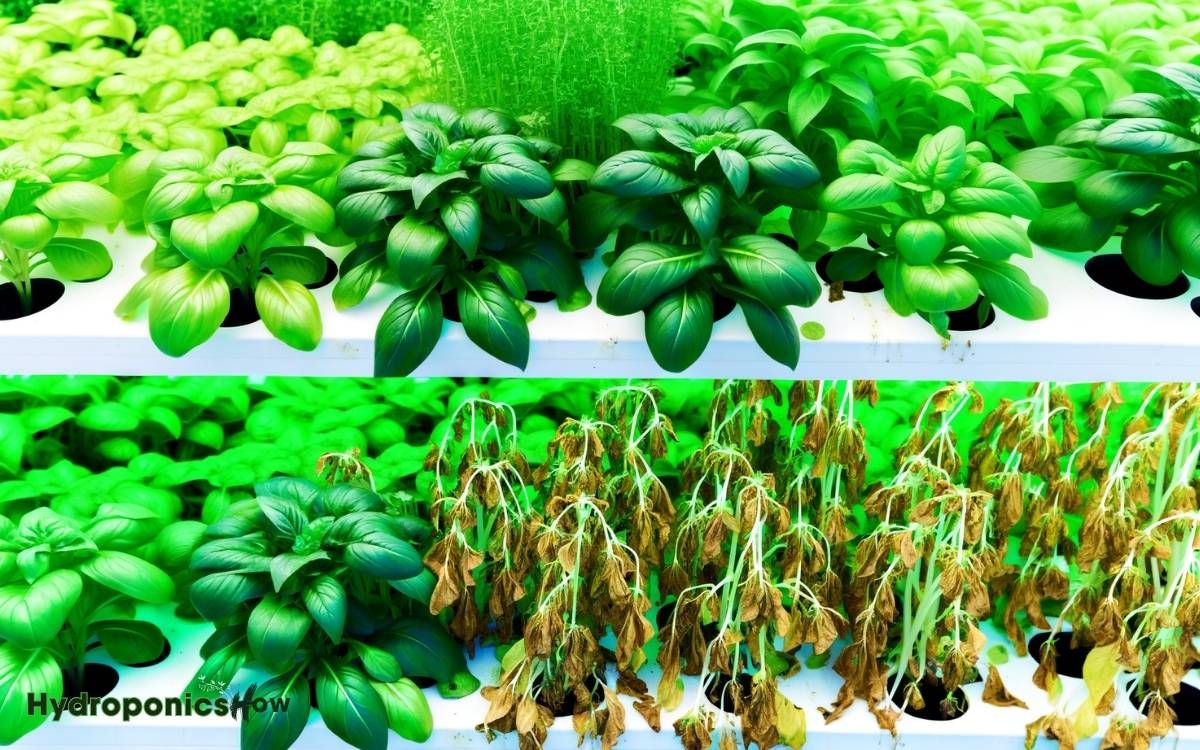
Key Takeaways
Ideal Temperature Range
Determining the essential temperature range is vital for optimizing plant growth in hydroponic systems.
You should aim to maintain a consistent air temperature between 68°F and 75°F (20°C to 24°C) for most crops. This range promotes efficient photosynthesis and nutrient uptake.
Data shows that temperatures above 82°F (28°C) can stress plants, leading to decreased growth rates and lower yields. Conversely, temperatures below 60°F (15°C) can slow metabolic processes, hindering development.
It’s important to monitor and adjust temperatures using reliable sensors and climate control systems. By doing so, you’ll make sure that plants remain within their ideal growth range, enhancing overall productivity and health.
Temperature and Root Health
Maintaining crucial temperatures is essential not just for the aerial parts of the plant but also for root health, as temperature fluctuations can greatly impact root function and nutrient uptake efficiency.
Roots exposed to temperatures below 15°C (59°F) can experience reduced metabolic activity, leading to slower growth and diminished oxygen absorption.
Conversely, temperatures above 30°C (86°F) can cause root stress and increase susceptibility to pathogens like Pythium.
Research indicates that maintaining root zone temperatures between 20°C and 25°C (68°F to 77°F) optimizes enzymatic activity and root respiration.
Utilizing water chillers or heaters allows you to regulate the root zone temperature, ensuring a stable environment.
Accurate temperature management bolsters root health, supporting overall plant vitality and growth in hydroponic systems.
Nutrient Uptake Efficiency
You need to maintain an ideal temperature range to maximize nutrient uptake efficiency in hydroponic systems, typically between 65-75°F.
Temperature stress, whether too high or too low, disrupts root function and impairs nutrient absorption, leading to stunted growth.
Balancing water temperature is essential, as it directly affects the solubility and availability of essential minerals.
Optimal Temperature Range
Achieving peak nutrient uptake efficiency in hydroponic systems hinges on maintaining the water temperature between 65°F and 75°F.
Within this range, plants can effectively absorb essential nutrients like nitrogen, phosphorus, and potassium.
Studies show that cooler temperatures below 65°F can slow metabolic processes, reducing nutrient absorption rates.
Conversely, temperatures exceeding 75°F can lead to oxygen depletion in the nutrient solution, hampering root respiration and nutrient uptake.
Data indicates that maintaining this ideal range promotes vigorous root development and maximizes photosynthetic efficiency.
Ensuring consistent water temperature within these parameters will help you achieve robust plant growth and higher yields in your hydroponic setup.
Regularly monitor and adjust temperatures to sustain these favorable conditions for optimal plant health.
Temperature Stress Impact
When water temperatures in hydroponic systems deviate from the ideal range, plants experience stress that greatly impairs nutrient uptake efficiency. This imbalance can lead to stunted growth, nutrient deficiencies, and increased vulnerability to disease. Proper regulation of water and oxygen in hydroponics is essential to maintaining root health and optimizing nutrient absorption. Without adequate oxygenation, roots may suffocate, further reducing their ability to take in essential minerals.
Elevated temperatures can reduce dissolved oxygen levels, causing root hypoxia and inhibiting nutrient absorption.
Conversely, cooler temperatures slow metabolic processes, decreasing nutrient transport rates. Studies show that temperatures above 30°C can lead to significant reductions in phosphorus and potassium uptake.
At temperatures below 15°C, nitrogen assimilation is particularly compromised. This imbalance in nutrient availability can lead to stunted growth, chlorosis, and reduced yield.
Monitoring and maintaining ideal water temperatures generally between 18°C and 24°C ensures that plants can efficiently absorb essential nutrients, promoting healthy growth and maximizing productivity in your hydroponic system.
Balancing Water Temperature
Maintaining ideal water temperature in hydroponic systems is essential for maximizing nutrient uptake efficiency and ensuring robust plant growth. You should aim for temperatures between 65-75°F (18-24°C). At this range, nutrient solubility and root oxygenation are optimized.
If water temperature exceeds 80°F (27°C), oxygen levels decrease, leading to hypoxic stress and reduced nutrient absorption. Conversely, temperatures below 60°F (15°C) slow metabolic processes, impairing nutrient uptake and growth.
Utilize digital thermometers and cooling systems like chillers or heaters to maintain stability. Empirical data shows that well-regulated water temperature can increase root mass by up to 20%, directly influencing overall plant health.
Proper temperature management is key to achieving peak hydroponic system performance.
Photosynthesis Rates
You need to understand how temperature fluctuations impact photosynthesis rates in hydroponic systems.
Maintaining an ideal temperature range, typically between 20-25°C, maximizes photosynthetic efficiency and biomass production.
Conversely, temperature stress outside this range can lead to reduced enzymatic activity and impaired chlorophyll synthesis, negatively affecting plant growth.
Optimal Temperature Range
An ideal temperature range of 20-25°C is essential for maximizing photosynthesis rates in hydroponic plant growth systems.
At this range, enzymes involved in the photosynthetic process operate at peak efficiency, enhancing the conversion of light energy into chemical energy.
If the temperature deviates, you may notice a significant drop in photosynthetic activity, leading to slower growth rates and lower yields.
| Temperature (°C) | Photosynthesis Rate (%) |
|---|---|
| 15 | 60 |
| 20 | 100 |
| 25 | 100 |
| 30 | 70 |
Maintaining this ideal temperature range ensures that plants can effectively utilize available light and nutrients. Monitoring and controlling the temperature within your hydroponic system will help you achieve consistent and robust plant growth.
Temperature Stress Effects
When temperatures deviate from the ideal range of 20-25°C, plants experience temperature stress, leading to a measurable decline in photosynthesis rates.
High temperatures can denature essential enzymes like RuBisCO, reducing the plant’s ability to fix carbon dioxide.
Conversely, low temperatures slow down enzymatic activity and hinder chlorophyll synthesis, decreasing light absorption efficiency. Research indicates that photosynthesis rates drop by approximately 5-10% for every degree
Celsius above or below this ideal range. You’ll notice reduced growth rates and lower yields as a direct consequence.
Monitoring and maintaining consistent temperatures in your hydroponic system is essential. Use temperature control technologies such as thermostats, heaters, and chillers to mitigate these detrimental effects and ensure efficient photosynthetic performance.
Water Temperature Impact
Ideal water temperature plays a critical role in hydroponic systems, directly affecting nutrient uptake, plant metabolism, and overall growth rates. When you maintain water temperatures between 65-75°F (18-24°C), plants can efficiently absorb nutrients, promoting peak growth.
Elevated temperatures above 80°F (27°C) can decrease dissolved oxygen levels, leading to root zone hypoxia and stunted growth. Conversely, temperatures below 60°F (15°C) can slow down metabolic processes, hindering nutrient assimilation and leading to deficiencies.
Data indicates that maintaining a consistent water temperature within the ideal range drastically improves root health and nutrient solution efficiency.
Monitoring and regulating water temperature ensures your hydroponic system operates at maximum performance, supporting robust plant development and maximizing yield potential.
Day Vs Night Temperatures
Balancing day and night temperatures in your hydroponic system can greatly influence plant respiration rates, photosynthesis efficiency, and overall growth dynamics.
During the day, higher temperatures optimize photosynthesis by activating key enzymes, while cooler night temperatures reduce respiration rates, conserving energy and promoting growth.
Here’s a data-driven overview:
| Time of Day | Best Temperature Range |
|---|---|
| Day | 22°C – 28°C |
| Night | 15°C – 20°C |
Maintaining this diurnal temperature range ensures that your plants maximize photosynthetic output during daylight hours and minimize energy expenditure at night.
It’s essential to monitor and adjust your system to these temperatures for peak plant performance. By doing so, you’ll achieve robust growth and healthier plants.
Seasonal Temperature Variations
Understanding how seasonal temperature variations impact your hydroponic system is crucial for maximizing plant growth year-round.
Summer temperatures can cause your nutrient solution to overheat, reducing dissolved oxygen levels and inhibiting plant root respiration.
Conversely, winter can drop temperatures below ideal ranges, slowing metabolic processes and stunting growth.
You should closely monitor and maintain your solution’s temperature within the preferred range of 65-75°F (18-24°C) for most plants.
Utilize data loggers to track fluctuations, and consider installing a climate control system.
Insulation and heaters can help stabilize temperatures during winter, while cooling systems and shade cloths can mitigate summer heat.
Regular adjustments based on seasonal data will ensure consistent growth and yield in your hydroponic setup.
Heat Stress Symptoms
When your hydroponic plants experience heat stress, you’ll notice symptoms like wilting, leaf burn, and reduced growth rates. Elevated temperatures can cause the plants’ transpiration rates to spike, leading to rapid water loss.
This table summarizes key symptoms and their effects:
| Symptom | Effect |
|---|---|
| Wilting | Decreased turgor pressure, limp foliage |
| Leaf Burn | Necrotic spots, chlorophyll degradation |
| Reduced Growth | Stunted development, inferior yield |
Heat stress disrupts photosynthetic processes, inhibiting chloroplast function and reducing carbohydrate synthesis. The plants’ metabolic rate increases, consuming more energy and depleting reserves faster.
Additionally, nutrient uptake efficiency drops, affecting overall plant health. Monitoring and controlling temperature is essential to mitigate these adverse effects and maintain favorable growth conditions in your hydroponic system.
Cold Stress Symptoms
Just as high temperatures can stress your hydroponic plants, exposure to cold conditions leads to symptoms like slowed growth, leaf discoloration, and root damage.
When temperatures drop below the ideal range (generally 18-24°C for most hydroponic systems), enzymatic activities slow down, impairing metabolic processes.
You’ll notice chlorosis, where leaves turn yellow due to reduced chlorophyll production. Cold stress also compromises root function, limiting nutrient uptake and water absorption.
Research indicates that root zone temperatures below 15°C greatly hinder nutrient transport, causing stunted growth and weakened plants.
Additionally, cold stress can make plants more susceptible to diseases like root rot. Monitoring and maintaining appropriate temperatures is vital to prevent these adverse effects and maintain the health of your hydroponic system.
Temperature Control Methods
To manage temperature effectively in your hydroponic system, you can insulate the grow environment using materials like reflective foils and thermal blankets. These materials help maintain stable temperatures.
Additionally, employing cooling systems such as evaporative coolers or chilled water systems can effectively mitigate excessive heat.
Data show that maintaining ideal temperatures enhances nutrient uptake efficiency and promotes robust plant growth.
Insulating Grow Environment
Ensuring ideal temperature conditions in a hydroponic system requires advanced insulation techniques and precise temperature control methods.
You should use reflective insulation materials, like Mylar or reflective bubble wrap, to minimize heat loss and gain. Insulating the grow room’s walls and ceiling helps maintain stable temperatures, critical for peak plant growth.
Data indicates that temperature fluctuations greater than 5°F can stress plants, reducing yield by up to 20%. Additionally, insulating nutrient reservoirs with foam boards can prevent temperature swings in the nutrient solution, ensuring consistent root zone temperatures.
Monitoring ambient and root zone temperatures with digital thermometers and employing radiant barriers will further stabilize the grow environment, enhancing plant health and productivity.
Utilizing Cooling Systems
Maintaining stable temperatures in a hydroponic system also necessitates utilizing advanced cooling systems like evaporative coolers, chillers, and heat exchangers to counteract excessive heat and guarantee ideal plant growth conditions.
- Evaporative coolers lower temperatures by evaporating water, which absorbs heat from the surrounding air.
- Chillers, employing refrigeration cycles, precisely manage nutrient solution temperatures, preventing root zone overheating.
- Heat exchangers transfer excess heat from the nutrient solution to a cooler medium, maintaining thermal equilibrium.
- Monitoring temperature data continuously with sensors and automated controls is crucial to ensure these systems operate efficiently.
Equipment for Temperature Management
Effective temperature management in hydroponics relies on precise equipment like digital thermostats, heating mats, and cooling systems.
You’ll need digital thermostats to regulate and maintain ideal water temperatures, typically between 65-75°F (18-24°C). Heating mats provide localized warmth to root zones, essential for consistent nutrient absorption, especially in cooler climates.
Cooling systems, such as water chillers, prevent overheating in nutrient solutions, which can stunt plant growth. Data-driven adjustments using these tools guarantee stable environments, essential for maximizing photosynthesis and transpiration rates.
Monitoring Temperature Levels
To guarantee ideal conditions for plant growth, consistently monitor temperature levels using accurate sensors and data logging systems. You should place sensors at various points within your hydroponic setup to capture thorough data.
Make sure sensors are calibrated for precise readings, and utilize a data logger to track temperature fluctuations over time. This allows you to identify patterns and address any deviations promptly.
Here’s a helpful table:
| Sensor Location | Ideal Temperature (°C) | Tolerance Range (°C) |
|---|---|---|
| Root Zone | 18-22 | ±2 |
| Canopy Level | 22-26 | ±3 |
| Ambient Air | 20-24 | ±2 |
| Water Reservoir | 18-20 | ±1 |
| Growth Chamber | 20-25 | ±2 |
Accurate monitoring guarantees optimal growth conditions and enhances yield reliability.
Balancing Humidity and Temperature
Balancing humidity and temperature in a hydroponic system is essential for preventing plant stress and ensuring ideal growth conditions.
Temperature affects plant metabolism, while humidity influences transpiration rates. To achieve this balance, you’ll need to monitor and adjust both variables carefully.
Consider the following steps:
- Use Hygrometers and Thermometers: Regularly measure humidity and temperature to maintain ideal levels.
- Install Climate Control Systems: Invest in HVAC systems to regulate the environment precisely.
- Adjust Watering Schedules: Higher temperatures may require more frequent watering, while high humidity might necessitate less.
- Implement Ventilation: Proper airflow prevents excess humidity and helps stabilize temperature.
Conclusion
In hydroponics, maintaining the ideal temperature range is essential for optimal plant growth.
You can’t underestimate the importance of temperature on root health, nutrient uptake efficiency, photosynthesis rates, and water temperature.
Think of it as a delicate dance where every step must be in sync.
By employing precise temperature control methods and equipment, and continuously monitoring levels, you’ll guarantee robust plant development.
Balancing humidity and temperature creates the perfect environment for your hydroponic success.

